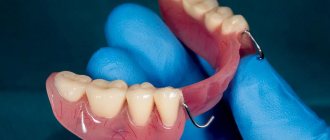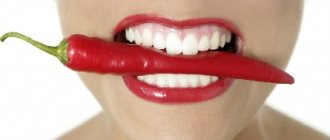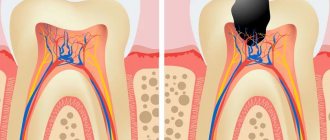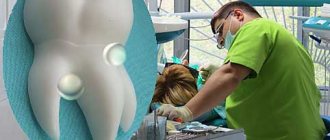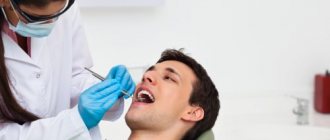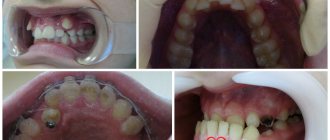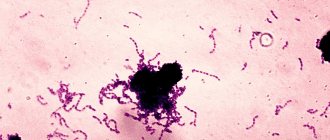After installing a prosthesis (in most cases a crown), unpleasant symptoms can be detected. This is pain, discomfort, swelling, the sensation of a foreign body in the oral cavity, and even suppuration of the tooth. This is due to improper installation of the prosthesis or independent diseases of periodontal tissue. If the material is incorrectly selected, an allergic reaction may develop. Vulture, itching, redness, and swelling appear on the mucous membrane. The troubles don't end there.
It often happens that a removable denture is installed incorrectly by the dentist or by the patient himself after cleaning. This does not mean the doctor is unprofessional; it happens that after orthopedic treatment, the tooth is injured or the enamel cracks. The reason for this may be injuries, biting hard objects, bad habits - holding a needle or coffee bean in your teeth, thread (these are more likely professional bad habits). All this cannot go unnoticed and both the jaw itself and the installed prosthesis suffer. Any complication after prosthetics can be associated with external or internal irritants, but each time it is accompanied by minor or severe pain.
Why does inflammation begin under the prosthesis?
At the present stage of orthopedic treatment, all materials are so carefully selected that the risk of complications is reduced to a minimum. But everything has its exceptions.
Poor canal filling before prosthetics is a mistake not of the orthopedist, but of the therapist. Incomplete filling of the tooth canal leads to the entry of unfavorable microflora into it, which multiplies and provokes inflammation of periodontal tissue. The patient feels pain, swelling at the site of the installed prosthesis, and pulsation. In this case, it is extremely necessary to re-treat and reinstall the prosthesis.
Inflammation may occur under a fixed prosthesis or crown if an instrument is left in the canal during treatment or the canal wall is perforated. In any case, 95% of complications are associated with improper root canal treatment.
A carious cavity under the prosthesis is a complication of prosthetics and is also associated with improper preparation for prosthetics. Caries under a denture develops in two cases: incomplete removal of carious tissues and non-compliance with the rules of sealants during prosthetics. When there are holes for food debris to penetrate, it always leads to the formation of plaque and caries.
How to get used to increased salivation or dryness
Increased salivation always goes away on its own. But if you wish, you can speed up this process. There are several proven methods for this:
- — After eating, you can rinse your mouth with water pepper extract diluted in water.
- - You can rinse your mouth with a decoction of Lagochilus intoxicating.
- “Rinsing with shepherd’s purse tincture also has a positive effect.
- — Viburnum berries poured into boiling water reduce salivation. The resulting infusion can be drunk and used for rinsing.
To eliminate dry mouth, you need to drink small sips of water as often as possible. It will also be useful to increase the amount of juicy vegetables and fruits in your daily diet. Dry mouth will be relieved by periodically sucking on low-sugar candies.
Among the folk methods there are also many that will eliminate dry mouth. Decoctions of chamomile, calendula, and St. John's wort not only reduce dry mouth, but also fight pathogenic microbes, help strengthen the gums, and help with inflammation of the mucous membrane. To prepare such a decoction, dry parts of the plant are poured with boiling water and left to infuse for several hours.
How to identify complications after installation of a prosthesis?
If there are doubts about the normal state of the mucous membrane under the prosthesis, you need to pay attention to several specific manifestations.
Swelling of the gums is a sure sign of the onset of the inflammatory process. The accumulation of purulent exudate under the gum can lead to serious consequences, and in this case you need to contact a dental surgeon. Swelling or gumboil can cause not only pain, but also tooth mobility, and this will lead to the need to replace the denture.
Fistula - acute inflammation of periodontal tissues can result in gumboil. And if the acute period of the complication went unnoticed, then the appearance of a fistula cannot be missed. If the fistula closes, acute inflammation begins again.
Cyst - if adequate treatment of chronic periodontitis was not carried out before prosthetics, it will end with a cyst. The cyst contains pus and appears on an x-ray as a black spot. The symptoms of a cyst are similar to periodontitis - pain when biting, swelling in the area of the causative tooth.
Causes of complications
After installing dentures, if signs of pathological processes appear in the oral cavity, you should immediately contact your dentist to eliminate the problem. The main reasons for complications during dental prosthetics are:
- insufficiently thorough preparation for the manipulation, which consists of refusing the proposed dental treatment, sanitation of the oral cavity and elimination of caries;
- incorrectly selected size of the prosthesis, resulting in discomfort while wearing it;
- poor-quality installation of the structure, which caused the appearance of gaps and cracks, the accumulation of food debris between the teeth, as well as the occurrence of inflammatory processes in the gums;
- breakage, damage or displacement of the denture;
- decreased immunity or allergic reactions caused by dental construction materials;
- displacement of individual teeth, resulting in movement of the entire structure as a whole;
- non-compliance with the rules of oral care after installation of a denture.
What to do if there is inflammation under the prosthesis?
The first thing to do is contact your doctor or, better yet, go to a good dental clinic that will offer several treatment options.
If prosthetics involves installing a pin, treatment becomes more complicated, since removing it from the root canal is quite difficult and can result in a root fracture. After this, the tooth will have to be completely removed. The issue of repeated prosthetics is quite complicated, since a root fracture can damage the bone plate and the implant cannot be installed, just like any pin.
When the cause of a complication after installing a crown is improper treatment of the canals, again the refilling is difficult and may result in perforation.
When it is possible to unseal the canal or remove the pin, anti-inflammatory therapy is carried out. After this, the canals are re-filled and a new prosthesis is installed.
We can conclude that it is better to carry out painstaking preparation for prosthetics and take into account all possible complications before installing the prosthesis, rather than treating the resulting inflammation.
How to fix the situation
If the removable denture does not stay in place, you need to make an appointment with an orthopedist. You cannot adjust dentures yourself. It can be so damaged that it cannot be repaired. In addition, in the absence of special tools and skills, it is possible to create a traumatic edge and provoke prosthetic stomatitis.
The doctor will correct, adjust or reline the structure and the problem will most likely be solved.
Sometimes, the patient cannot get used to the restoration or, due to anatomical features, the denture falls off and no measures help. In such cases, implant prosthetics are recommended.
Implantation is the implantation of titanium rods into the bone tissue, which act as a tooth root. The prosthetic structure is then attached to them. This can be either a single crown or a full jaw restoration. This type of prosthetics will allow you to forget about the loss of an artificial jaw. Implantation stops bone tissue atrophy and restores normal chewing function.
An example of dental prosthetics on implants
Caring for fixed structures is easier, they are attached better and creams and gels are no longer needed. It is enough to brush them like regular teeth and undergo a preventive examination.
Proper production of dentures
During the manufacturing process[1], it is important to follow all the nuances of the technological process (it is different for each material). If a mistake is made at any stage, then a defect may appear in the product, and the fit will not be tight. Chewing with such “teeth” is not only inconvenient, it is impossible.
Therefore, choose experienced orthopedic doctors. Also, priority should be given to clinics that either have their own dental laboratories or have entered into an agreement with a large modern laboratory.
Fixation means
Almost all people who wear removable structures are familiar with fixation cream. Popular brands are Corega, Protefix, Fittydent, LACALUT, PresiDENT. There are also fixing pads and powders based on sodium alginate. All these products are applied to a cleaned, moistened denture, it is installed in place and glued to the gums.
Manufacturers claim that in this way, a poorly fitting structure will gain good fixation for 8-12 hours. But in practice and according to patient reviews, the action lasts only a couple of hours or even before the first meal.
“When they made an acrylic remover for me, I couldn’t use it without cream at all. Food got stuck under my gums, which was not pleasant. The clasps did not cling well to the teeth. Corrections at the dentist also did not help much. So I save myself with cream, although I still can’t chew something tough like shish kebab. And the cream has a specific taste, you need to get used to it.”
Evgeniy Nikolaevich, review from the dentistry.rf forum
Habituation and home care
A properly completed adaptation period and regular care are the key to making wearing an artificial “jaw” more comfortable (although getting used to it is difficult). Let's figure out what's what. In the first days (a week or two), you need to sleep with the denture in your mouth - this way adaptation will happen faster. Normally, the feeling that it is in the way, pressing, or trying to fall out should gradually disappear.
Caring for the “removers” involves removing them after every meal or any snack in order to clean and rinse the structure. In the morning and evening, thorough cleaning is carried out using a brush and paste. Once or twice a week it should be soaked in an ultrasonic bath or in a container with a disinfectant solution. And every 6 months you should visit the dentist for professional cleaning of the structure and examination of the oral cavity. A set of care procedures will help protect the denture base from tartar buildup and preserve the properties of the material - for a tight fit of the structure to the gums.
Remember what foods should not be eaten with artificial teeth - these are hard and stretchy foods. It is their fault that breakages occur and the tightness of the seal to the gums and supporting teeth is disrupted.
Prosthetics with complete edentia
Clasp dentures cannot be used with complete edentia, so in this case the optimal choice is the Quattro Ti design. Many experts classify this model as a clasp type, but it is based on no metal elements that could injure the enamel and gums. In addition, such a prosthesis can be used with complete edentia - it can only be fixed on the gums.
Another good option is Akri Free dentures, which meet high demands on aesthetics and durability. As for acrylic solutions, when restoring the lower row in the absence of all teeth, the fixation of the apparatus will be rather weak. As an alternative, you can resort to conditionally removable prosthetics using an acrylic device supported by implants.
Let us quote D. Jerryson, a professor at New York University College of Dentistry, who specializes in research in the field of dental prosthetics: “When choosing a specific model of removable denture, it is necessary to take into account the clinical picture as a whole. If Quadrotti is a universal option, then clasp solutions can be fixed only if there are supporting elements of the dentition. Among the less convenient but budget options, it is worth highlighting acrylic dentures, but the final choice can only be made by a qualified specialist after conducting an appropriate examination.”
Next, we will consider in detail the types of modern orthopedic systems that are most often chosen to restore both part of the teeth and the entire dentition in the lower jaw.
Preparation and full diagnostics before prosthetics
It is impossible to make comfortable dentures without a responsible approach to diagnostics before prosthetics and to the preparation of the oral cavity. In order for dentures - acrylic, nylon, clasp and others - to be comfortable, you need to undergo several studies. All of them will be useful for identifying contraindications, as well as for accurately modeling the prosthetic structure.
The first thing in diagnosis is an x-ray, panoramic image (OPTG) or CT (computed tomography) of the jaw. The second is taking impressions or impressions of the teeth. By the way, today you can make not ordinary impressions, but digital ones - using an intraoral scanner. The third is functional diagnostics, where bite parameters are assessed in dynamics, i.e. how the patient chews. This is one of the most important factors for making a prosthetic product comfortable. Otherwise, it can only be worn for beauty. Such diagnostics consists of assessing the work of the masticatory muscles, the movements of the jaw joints, and the closure of the jaws during movement.
Read on the topic: digital diagnostics before prosthetics - how modern devices help make comfortable dentures.
As part of the preparation, it is necessary to cure all identified dental diseases - eliminate caries, pulpitis, properly fill and strengthen the root canals. So that later the supports under the prosthesis do not fail, and it does not wobble, it fits tightly.
Complex on 4 OSSTEM implants with delayed loading - from RUB 170,000.
Complex implantation Osstem (South Korea) with delayed loading after 4-6 months.
Guarantee for the doctor’s work - unlimited Call now or order a call
Opening hours: 24 hours a day - seven days a week
Professional correction: relining, editing
Adjustment of a removable denture (relining, editing) is an adjustment of its dimensions to the changed anatomy of the prosthetic bed. Since bone atrophy does not stop when wearing such structures, and sometimes even intensifies, over time the base will not fit tightly, will begin to wobble and fall out. To increase comfort, the doctor can file down protruding areas or build up the acrylic base during the appointment - this is a clinical method. It is fast, but there is a higher risk of the patient becoming allergic to acrylic, and lower reliability.
Relocation of removable structures should be carried out according to indications. On average, every 3-6 months, depending on the rate of atrophy and the softness of the base material.
With the laboratory method, new impressions must be taken from the jaws and sent to the dental laboratory along with the prosthetic structure. The technician will modify the product in accordance with the new parameters so that it fits tightly to the atrophied areas. This method is optimal in terms of convenience and durability, plus the risk of allergies is much lower. But the adjustment will take more time - up to 5-7 days.
